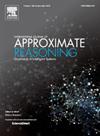Towards machine learning as AGM-style belief change
IF 3
3区 计算机科学
Q2 COMPUTER SCIENCE, ARTIFICIAL INTELLIGENCE
引用次数: 0
Abstract
Artificial Neural Networks (ANNs) are powerful computational models that are able to reproduce complex non-linear processes, and are being widely used in a plethora of contemporary disciplines. In this article, we study the statics and dynamics of a certain class of ANNs, called binary ANNs, from the perspective of belief-change theory. A binary ANN is a feed-forward ANN whose inputs and outputs take binary values, and as such, it is suitable for a wide range of practical applications. For this type of ANNs, we point out that their knowledge (expressed via their input-output relationship) can symbolically be represented in terms of a propositional logic language. Furthermore, in the realm of belief change, we identify the process of changing (revising/contracting) an initial belief set to a modified belief set, as a process of a gradual transition of intermediate belief sets — such a gradualist approach to belief change is more congruent with the behaviors of real-world agents. Along these lines, we provide natural metrics for measuring the distance between these intermediate belief sets, effectively quantifying the disparity in their encoded knowledge. Thereafter, we demonstrate that, similar to belief change, the training process of binary ANNs, through backpropagation, can be emulated via a sequence of successive transitions of belief sets, the distance between which is intuitively related through one of the aforementioned metrics. We also prove that the alluded successive transitions of belief sets can be modeled by means of rational revision and contraction operators, defined within the fundamental belief-change framework of Alchourrón, Gärdenfors and Makinson (AGM). Thus, the process of machine learning (specifically, training binary ANNs) is framed as an operation of AGM-style belief change, offering a modular and logically structured perspective on neural learning.
将机器学习作为agm风格的信念改变
人工神经网络(ann)是一种强大的计算模型,能够再现复杂的非线性过程,并被广泛应用于众多当代学科。本文从信念变化理论的角度研究了一类被称为二元人工神经网络的静力学和动力学。二进神经网络是一种前馈神经网络,其输入和输出均取二进值,因此具有广泛的实际应用价值。对于这种类型的人工神经网络,我们指出它们的知识(通过它们的输入输出关系表示)可以用命题逻辑语言符号表示。此外,在信念变化领域,我们将初始信念集的变化(修改/收缩)过程确定为中间信念集的逐渐过渡过程,这种渐进的信念变化方法更符合现实世界智能体的行为。沿着这些思路,我们提供了测量这些中间信念集之间距离的自然度量,有效地量化了它们编码知识的差异。随后,我们证明,与信念变化类似,通过反向传播,二元人工神经网络的训练过程可以通过一系列连续的信念集过渡来模拟,这些信念集之间的距离通过上述指标之一直观地相关。我们还证明了在Alchourrón、Gärdenfors和Makinson (AGM)的基本信念变化框架内定义的理性修正算子和理性收缩算子可以对所提到的信念集的连续跃迁进行建模。因此,机器学习的过程(特别是训练二元人工神经网络)被框架为agm风格的信念变化操作,为神经学习提供了模块化和逻辑结构化的视角。
本文章由计算机程序翻译,如有差异,请以英文原文为准。
求助全文
约1分钟内获得全文
求助全文
来源期刊

International Journal of Approximate Reasoning
工程技术-计算机:人工智能
CiteScore
6.90
自引率
12.80%
发文量
170
审稿时长
67 days
期刊介绍:
The International Journal of Approximate Reasoning is intended to serve as a forum for the treatment of imprecision and uncertainty in Artificial and Computational Intelligence, covering both the foundations of uncertainty theories, and the design of intelligent systems for scientific and engineering applications. It publishes high-quality research papers describing theoretical developments or innovative applications, as well as review articles on topics of general interest.
Relevant topics include, but are not limited to, probabilistic reasoning and Bayesian networks, imprecise probabilities, random sets, belief functions (Dempster-Shafer theory), possibility theory, fuzzy sets, rough sets, decision theory, non-additive measures and integrals, qualitative reasoning about uncertainty, comparative probability orderings, game-theoretic probability, default reasoning, nonstandard logics, argumentation systems, inconsistency tolerant reasoning, elicitation techniques, philosophical foundations and psychological models of uncertain reasoning.
Domains of application for uncertain reasoning systems include risk analysis and assessment, information retrieval and database design, information fusion, machine learning, data and web mining, computer vision, image and signal processing, intelligent data analysis, statistics, multi-agent systems, etc.
 求助内容:
求助内容: 应助结果提醒方式:
应助结果提醒方式:


